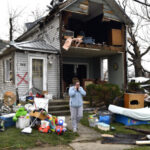The University of Nevada’s world-renowned earthquake laboratory has launched a nearly $4 million research project aimed at making nonstructural parts of buildings more earthquake proof.
Engineers at the school’s Large-Scale Structures Lab cranked up three 50-ton capacity shake tables on the Reno campus Monday to simulate a quake as part of the groundbreaking project funded by the National Science Foundation.
Engineering College dean Manos Maragakis said nonstructural items like water pipes, partition walls and ceiling tiles are not critical to structural integrity. But he said such parts account for about 85 percent of a typical building’s value.
“They also can cause lots of damage and down time because the building can’t be used, and they can cause injuries or death,” Maragakis told the Reno Gazette-Journal.
“For example, a hospital after an earthquake might be structurally sound, but you get inside and it’s a mess,” he said. “The pipes have broken and the ceilings have fallen. So they can’t use it and the hospital has to be closed.”
Kazuhiko Kasai, director of the Structural Engineering and Research Center at the Tokyo Institute of Technology, was among about a dozen engineers and professors who traveled from Japan to observe Monday’s test. Earthquake simulations can be run on computers, but they don’t provide the same realistic information as Nevada’s lab, he said.
“You know, Japan is very advanced in terms of building protection, but we have not fully developed protection with the non-structural components,” Kasai said. “That really became a very big issue immediately after the (2011) Tohoku earthquake. Many ceilings fell down.”
Gov. Brian Sandoval planned to visit the site on Tuesday when another simulation was scheduled.
The research project is one of only three Grand Challenge grants the National Science Foundation is funding, Maragakis said. The other two went to the University of California, Berkeley and the Georgia Institute of Technology.
Maragakis is the lead researcher on the UNR project and is working in collaboration with researchers at other institutions, including Cornell University.
“I am excited that the governor is coming here, but I am even more excited that 11 Japanese came here for one day just to see the test,” he said. “`It shows how important this is and it also shows the reputation that we have at this university. Reno should be proud to have the biggest (earthquake simulation) facility in the country.”
It’s also one of the largest in the world with a 10,000 square-foot laboratory.
A 3 1/2 story expansion, scheduled to open in December, will give UNR’s earthquake laboratory a total of 32,000 square feet, Maragakis said.
Japan’s facility is about 50,000 square feet, he said, but it only has one shake table to UNR’s four, which are moveable and allow the Reno lab to reconfigure the tables to represent different structural designs.
Was this article valuable?
Here are more articles you may enjoy.

 Harvard Study Again Stirs the Pot on Demotech Ratings of Florida Carriers
Harvard Study Again Stirs the Pot on Demotech Ratings of Florida Carriers  Gallagher: Global Insured Natural Disaster Claims Again Dominated by Severe U.S. Storms
Gallagher: Global Insured Natural Disaster Claims Again Dominated by Severe U.S. Storms  EVs Head for Junkyard as Mechanic Shortage Inflates Repair Costs
EVs Head for Junkyard as Mechanic Shortage Inflates Repair Costs  Beyond the Claim: How Social Canvassing is Transforming Insurance Fraud Detection
Beyond the Claim: How Social Canvassing is Transforming Insurance Fraud Detection 